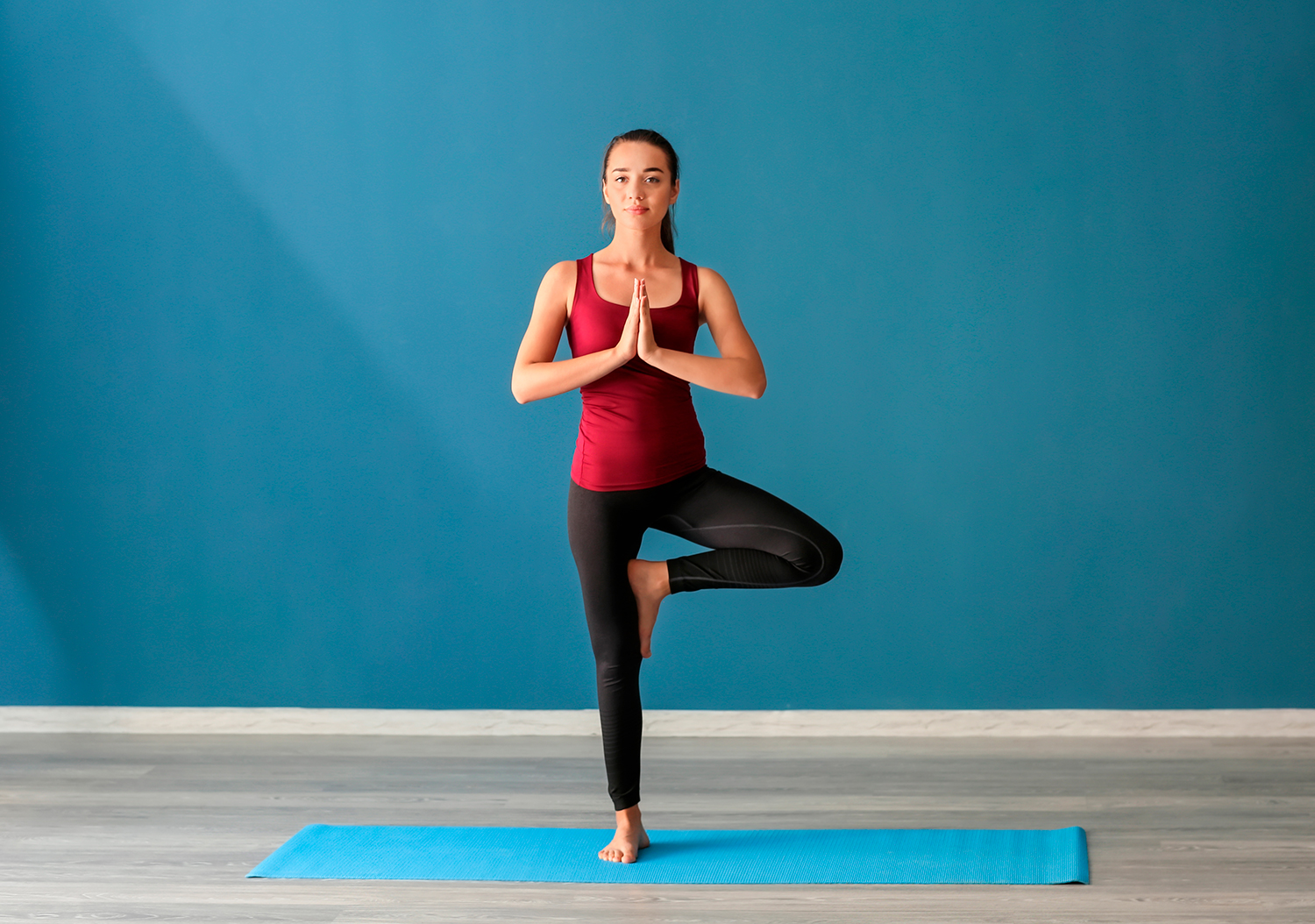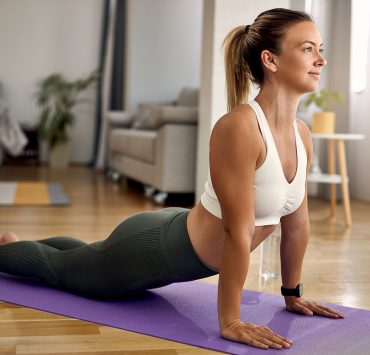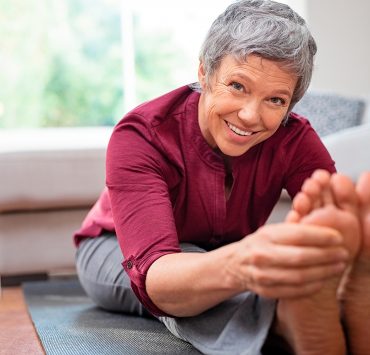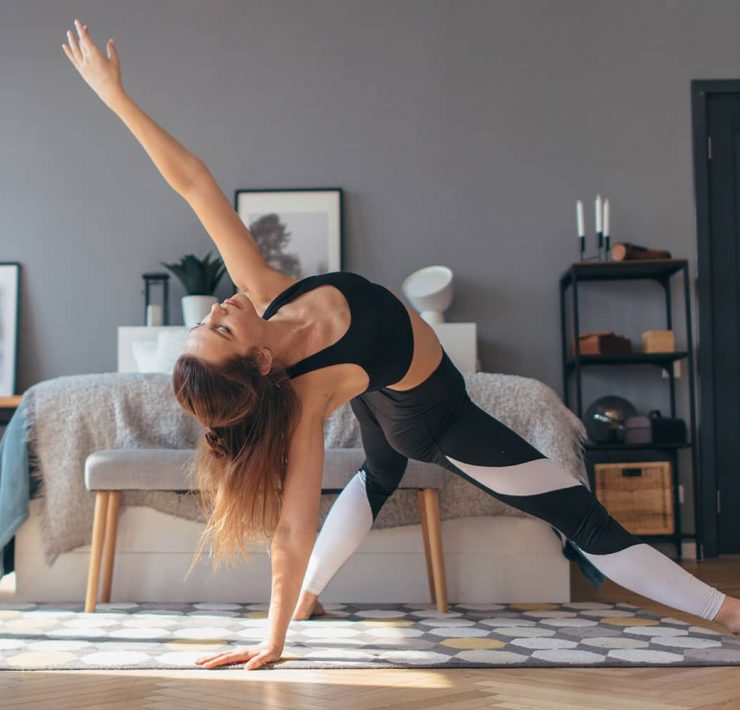
Catherine Perez is a celebrated yoga instructor in her home…
Sometimes it can get confusing with so many different types of yoga to choose from. One that you’ll recognize is hatha yoga, which is widely considered to be one main category of yoga. It blends numerous concepts and ideas of yoga principles to combine poses, breathing, and mental consciousness to promote a healthy body, mind, and spirit.
A typical hatha yoga class will include a series of physical poses and breathing techniques which are practiced at a slower pace than other yoga types, such as Vinyasa yoga which moves at a faster pace to increase body heat. Hatha yoga uses postures intended to calm the mind and breathing, preparing you for relaxation and meditation.
Continue reading to learn more about the history of hatha yoga, its many benefits, and how to get started with a beginner sequence flow to get you started.
History of Hatha Yoga

Most of yoga’s terminology is based on Sanskrit, an ancient Indian language. The word hatha in Sanskrit means “forceful” or “willful”, which translates to “a forceful yoga”.
The word hatha itself is composed of two Sanskrit words – Ha, which represents the sun. And Tha, which represents the moon. Hatha yoga is all about balancing the two opposites that make us a whole. The balancing of the sun and moon that resides within each of us is done through hatha yoga postures, where each pose is intended to bring us harmony of the body, mind, and spirit.
The most well-known text that discusses hatha yoga is the Hatha Yoga Pradipika, dated from the 15th century. The text goes into detail about hatha yoga, including information about asanas, pranayama (breath), and chakras (energy centers of the body). There are fifteen main poses listed in the book – both seated and standing poses. Also included are other postures for a total of 84 different asanas.
What is Hatha Yoga

In the Western world, hatha is all about focusing on asanas, the many physical poses and postures that make up this discipline. With the definition of being a forceful yoga, hatha is the physical movement of the body in various ways, including asanas, mudras (hand gestures), and mantras, where voice is used for chanting.
Many of the asanas used today are a variation on ancient asanas, which weren’t just poses, but also included mudras to attract and seal energy into the body and mind. These poses are usually linked into a series of hatha sequences, also known as a hatha flow. In this series of poses the movement passes from one pose into the next in a smooth flow without interruption. There are some common sequence flows that you’ll know from one yoga class and teacher to another. Other sequences are created by yoga teachers before a class, often with a specific goal in mind, such as a sequence intended to energize you in the morning.
But what makes a hatha sequence different from any other yoga class that you take? The aim of hatha yoga is much the same as other yoga forms, but with more emphasis to use asanas and breath at a slower pace to master the poses.
The Many Benefits of Hatha Yoga

Hatha yoga is perhaps the most widely practiced yoga type in the West – it focuses on physical asanas that are usually done in a sequence. Practicing hatha yoga even just 2 to 3 times per week comes with numerous benefits. Whether you have a relaxing class or one that energizes you, here’s what hatha yoga can do for you.
Physical benefits
- Build up immunity. As your body moves through each asana your body stretches and contracts muscles, massaging internal organs. This helps to drain the lymph glands, encouraging the lymphatic system to get rid of harmful toxic wastes and allow the body to fight infection more effectively.
- Improves flexibility. Moving into yoga poses and through the hatha sequence increases your flexibility. As we get older, this flexibility helps keep the body agile and less prone to injury.
- Tones the body. Many hatha postures are weight bearing. Holding these postures and coming back to them a few times through your practice helps to strengthen the body.
- Conditions and tones the spine. Hatha yoga keeps your spine flexible and supple, allowing the nerve impulses to flow freely so they stay strong and resistant to disease.
- Heart health. A regular practice of hatha yoga may be effective in managing and controlling hypertension, which is one of the leading causes of heart attack and cardiovascular disease.
- Improve bone density. Weight bearing postures, such as Triangle pose, may improve bone density which can reverse the effects of bone loss. This is particularly important for anyone dealing with osteoporosis or osteoarthritis.
Mental benefits
- Relieve anxiety, stress, and depression. As you breathe through your hatha yoga practice, your prana flows freely. This can help release anxiety and tension in the body, which in turn helps to relax the mind. When left unmanaged, anxiety can often lead to depression.
- Improve mental clarity. Practicing hatha yoga helps to clear the mind, which in turn enables the brain to “think” better, with a sharper memory and better concentration and focus.
- Improves daily outlook. After your hatha yoga class, you’ll feel more enlightened and carefree. Using various asanas helps to cleanse your mind of negative thoughts and feelings, making you feel more positive.
Spiritual benefits
When practiced regularly, the physical poses of hatha yoga provide you with a sense of well-being and health. This state of balance is an important step in allowing your body and mind to prepare for spiritual growth as your energy moves through you. Preparing your body to become spiritually enlightened is an important aspect of hatha yoga, with asanas helping you reach your own personal growth.
The next time you come to the end of your hatha yoga practice, sit in silence and meditate. This is the perfect time to look inwards and allow yourself some time to enjoy the inner spirituality you’ve just created through asanas and breathing.
The Basics of Hatha Yoga Poses and Asanas
Hatha yoga uses physical asanas and breathing to connect the body with the soul. Many of the poses focus on the alignment of the spine. Here are 12 basic asanas that can be used in a sequence or as part of other sequences.
Sirsasana – Headstand Pose

This asana is practiced by balancing on your head, arms, and elbows. This pose is also called “the king of all asanas”. When in the Headstand, oxygen and nutrients flow to the face, increasing blood flow to the head. This asana good for detoxifying the adrenal glands, relieving stress, and building up the core muscles.
Sarvangasana – Shoulderstand Pose

Not a beginner pose, the Shoulderstand is performed by balancing your body on your shoulders with the chin pressed into the throat, helping to regulate the thyroid gland. The pose is also known as “the queen of all asanas” as it helps to balance and harmonize all the organs and chakras in the body. The Sarvangasana is beneficial for relieving depression and anxiety, treating infertility and asthma, and relieving some of the symptoms of menopause.
Halasana – Plough Pose

The Halasana is an inverted back pose that provides an excellent stretch along the shoulders and spine. It helps to build strength and flexibility throughout the back muscles, encouraging flexibility in the spine. It also helps to strengthen the immune system and stimulate the thyroid glands and the reproductive system. The pose is often recommended for women in menopause.
Matsyasana – Fish Pose

Fish pose is done lying on the floor, with the back bending up off the ground. It opens up the abdomen, chest, and throat while at the same time building up flexibility in the spine and neck. Do this pose to build up balance and to relieve menstrual discomfort.
Paschimottanasana – Sitting Forward Bend Pose

Use a strap if needed for this pose. In Paschimottanasana, while keeping the legs straight out in front of you, bend forward. Place your hands on your feet, letting the elbows fall outwards. This asana helps to relieve stress and anxiety and may also be used to treat hypertension and diabetes. During a hatha sequence, Paschimottanasana is usually practiced in the middle of the class, when the body is fully warmed up.
Bhujangasana – Cobra Pose

Lying on your stomach, the Cobra pose is performed by expanding the chest and arching the upper body upwards. The posture improves flexibility and helps to strengthen and rejuvenate nerves in the spine. It also helps to improve digestion, relieve menstrual pain, and stimulate organs in the stomach.
Salabhasana – Locust Pose

An intermediate pose, the Salabhasana helps prepare beginners for the more advanced backbend postures. It brings a good stretch to the entire back, building up strength and flexibility. The Locust pose is energizing and boosts blood circulation throughout the entire body.
Dhanurasana – Bow Pose

A back-bending posture, the Bow pose helps to strengthen the core and back muscles. As it opens up the shoulders, chest, and neck it helps with liver function and intestine problems.
Ardha Matsyendrasana – Half Spinal Twist Pose

This seated pose has numerous benefits for the body – as you twist into the pose your nervous system is massaged which helps to tone core muscles, improve digestion, and increase flexibility. This asana is also ideal for calming the mind and bringing a sense of peace.
Kakasana – Crow Pose

Another balancing pose, Kakasana takes regular practice to perform. The posture tones the core muscles and helps to strengthen the forearms, upper arms, and shoulders.
Pada Hasthasana – Standing Forward Bend Pose

The Pada Hasthasana is a deep forward stretch that keeps the back muscles toned. Other benefits of this asana include relief from menstrual issues and menopause. It can also help to treat infertility, asthma, and hypertension.
Trikonasana – Triangle Pose

Used in many sequences, the Triangle pose helps to reduce anxiety and stress and increase mental clarity and focus. Physically, the pose opens up the hips and stretches the leg muscles. Use this posture to stretch before more physical and challenging asanas.
Hatha Sequences

The variety of Hatha sequences is endless, with each yoga teacher having their favorite. Sequences are built to accommodate beginners, intermediates, and those ready for sequences that use challenging postures. Still other hatha sequences target specific heath issues such as weight loss or menopause.
Sequence for beginners:
Hatha yoga is often recommended for adults and seniors who are not physically active and who want to improve their fitness level. This short beginner sequence is a gentle introduction to the hatha asanas:
- Mountain Pose – Begin in Tadasana. Stand tall with your arms by your side. Keep your breathing even and slow, looking at a spot in front of you for focus. Hold the pose for 2 minutes.
- Tree Pose – Move from Mountain into Tree pose, balancing as best you can with the left foot on the inner edge of your right thigh. With hands folded in Namaste position, hold the pose for 30 to 60 seconds. Repeat with the right foot on the left thigh.
- Standing Forward Bend – Take a deep breath as you move into Uttanasana, bending at the hips to rest your hands on the back of your ankles. Remain in the posture for 20 seconds.
- Downward Facing Dog – Move into Downward Dog, exhaling as you move into position. Make sure your head is aligned with your arms, keeping your eyes on your navel. Hold the pose for 30 seconds.
- Bridge Pose – Lay on your back and prepare for Bridge pose. This Setu Bandhasana posture should be performed with a focus on breath, breathing out as you lift your posterior and lower back off the mat. Remain in Bridge pose for 30 to 60 seconds.
- Locust Pose – Roll over to your stomach and gently move into Salabhasana. Breathing out, lift your chest, torso, arms and legs off the floor as best you can – it may take practice to fully lift. Hold the pose for 30 – 60 seconds.
- Savasana – Move into Corpse pose to relax and center yourself. Remain in Savasana for 5 to 10 minutes.
Any practice of Hatha yoga uses a combination of techniques that include postures and breath work to change the way we feel physically, mentally, and spiritually. The physical asanas not only benefit our health and fitness, they also wake up our inner energies and open our mind to the world within and around us.
Through your yoga practice, you can unite with this amazing energy that helps you find balance in this busy world. There may be days when you’re consciously drawn to your yoga mat without fully understanding why. When you reach this point, you know that your hatha practice has become a deep intention that is no longer separate from your life but a part of your core being.
What's Your Reaction?
Catherine Perez is a celebrated yoga instructor in her home state of Connecticut, and she also happens to have a marvelous way with words. Her mindful writing technique is easy to digest and gives readers a unique opportunity to learn from a seasoned yogi.














